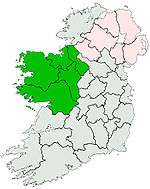Benbulbin
Benbulbin,[1][2] sometimes spelled Ben Bulben or Benbulben (from the Irish: Binn Ghulbain), is a large flat-topped rock formation in County Sligo, Ireland. It is part of the Dartry Mountains, in an area sometimes called "Yeats Country".[3][4][5]
| Benbulbin | |
|---|---|
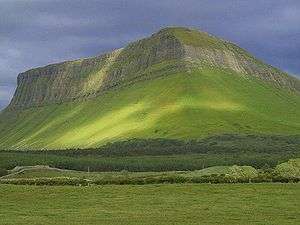 Benbulbin's northern side on a cloudy day. | |
| Highest point | |
| Elevation | 526 m (1,726 ft) |
| Listing | Marilyn |
| Coordinates | 54°22′N 8°28′W |
| Naming | |
| Native name | Binn Ghulbain (Irish) |
| Geography | |
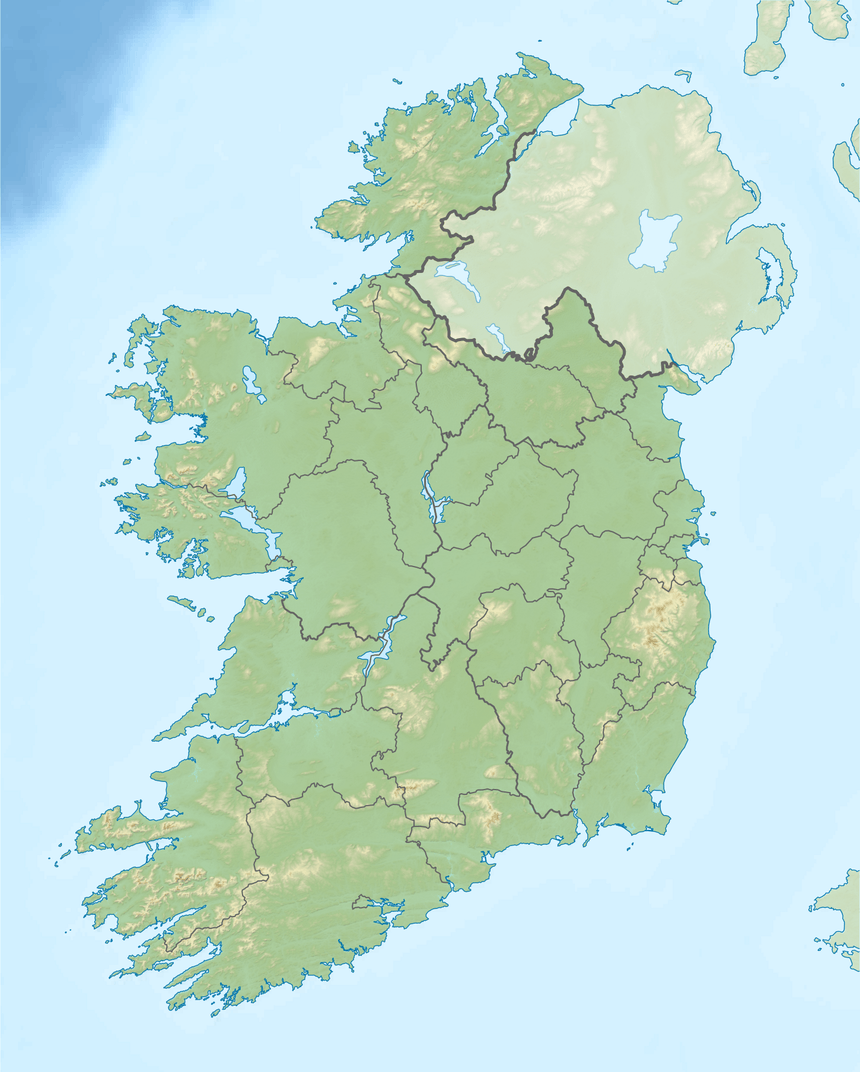 Benbulbin Ireland | |
| Location | Sligo, Republic of Ireland |
| Parent range | Dartry Mountains |
| OSI/OSNI grid | G692463 |
| Topo map | OSi Discovery 16 |
| Climbing | |
| Easiest route | Hike |
Benbulbin is a protected site, designated as a County Geological Site by Sligo County Council.[6][7]
Etymology
"Ben Bulben", "Benbulben", and "Benbulbin" are all anglicisations of the Irish name "Binn Ghulbain". "Binn" means "peak" or "mountain", while "Ghulbain" may mean beak or jaw, or may refer to Conall Gulban, a son of Niall of the Nine Hostages who was associated with the mountain.[3][8]
Geology
Formation
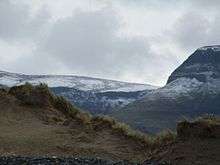
Benbulbin was shaped during the ice age, when Ireland was under glaciers. Originally it was a large plateau. Glaciers moving from the northeast to southwest shaped it into its present distinct formation.[4][9]
Rock composition
Benbulbin, and the Dartry Mountains as a whole, are composed of limestones on top of mudstones. These rocks formed in the area approximately 320 million years ago in a shallow sea. Uppermost in the limestone layer is a thicker, harder limestone called the Dartry Limestone Formation. Below this is a thinner transitional limestone formation – the Glencar Limestone Formation. Further down, the lower slopes consist of shaly mudstone known as the Benbulben Shale Formation. Scree deposits are found near the base.[4][6]
Fossils exist throughout the layers of the mountains. All layers have many fossilised sea shells. The shale layer also holds some corals.[6]
Baryte was mined at Glencarbury near Benbulbin in the Dartry range between 1894 and 1979.[6]
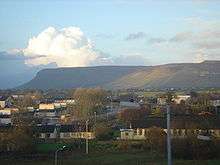
Climbing
Benbulbin is an established walking destination.[10][11][12] If climbed by the north face, it is a hazardous climb. That side bears the brunt of the high winds and storms that come in from the Atlantic Ocean. However, if approached by the south side, it is an easy walk, since that side slopes very gently. From the summit there are views over the coastal plain of north County Sligo and the Atlantic ocean.[4] The land adjacent to the western edge of the ridge is privately owned farmland and not accessible to the general public. However, there is a paved path up the south face to the east near Glencar Waterfall just over the County Leitrim border.
Walking
One of the trails running alongside Benbulbin mountain is the Gortarowey looped walk. It runs both through the forest and out in the open overlooking Benbulbin and the bay of Donegal. It is 5.5 kilometres (3 mi) in length and takes approximately 1.5 hours to walk.[13]
Flora and fauna
Benbulbin hosts a variety of plants, including some organisms found nowhere else in Ireland. Many are Arctic–alpine plants, due to the mountain's height, which allows for cooler temperatures than is normal. These plants were established after the glaciers that created Benbulbin melted. Wild hares and foxes inhabit Benbulbin.[4]
In 2012, research revealed that the fringed sandwort had survived the Ice Age and is perhaps 100,000 years old. In Ireland the plant is unique to Benbulbin. The discovery calls into question the prior consensus that Ireland's flora and fauna date from or after the end of the Ice Age.[14]
In Irish history
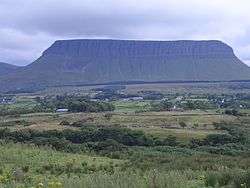
Irish legends
Benbulbin is the setting of several Irish legends. It is said to be one of the hunting grounds of the Fianna, a band of warriors who are said to have lived in the 3rd century. One example is the story of The Pursuit of Diarmuid and Gráinne,[15] in which the warrior Diarmuid Ua Duibhne (Diarmuid) is tricked by the giant Fionn mac Cumhaill (Finn McCool) into fighting an enchanted boar, which later kills the warrior by piercing his heart with its tusk. McCool is also said to have found his long-lost son Oisín at this location. The mountain is said to be Diarmuid and Gráinne's resting place. Also, in the 6th century, St. Columba fought a battle on the plain below Benbulbin at Cúl Dreimhne (Cooladrumman) for the right to copy a Psalter he had borrowed from St. Finnian.[16]
Irish Civil War
On 20 September 1922, during the Irish Civil War, an Irish Republican Army column, including an armoured car were cornered in Sligo. The car was destroyed by another armoured car belonging to the Irish Free State's National Army, and six of the IRA soldiers fled up the Benbulbin's slopes. In the end, all were killed, allegedly after they had surrendered. They are known as the "Noble Six".
Brigadier Seamus Devins TD, Div. Adj. Brian MacNeill, Capt. Harry Benson, Lieut. Paddy Carroll, Vols. Tommy Langan and Joe Banks were those killed on the mountain.[17] The six anti-treaty fighters were hunted down on the slopes of Benbulbin and put to death by Free State forces which were out to avenge the killing of Brigadier Joseph Ring eight days earlier. Two of those killed and Ring were ancestors of current and recent politicians: Ring is the grand uncle of Michael Ring, McNeill is the uncle of former Tánaiste and Minister for Justice, Equality and Law Reform Michael McDowell and Devins is the grandfather of Jimmy Devins.[18] Mary O'Rourke once narrated a radio documentary telling how her grandmother's home was used as a safehouse.[18]
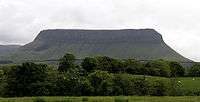 Benbulbin's northern side.
Benbulbin's northern side. Another photograph of the northern side.
Another photograph of the northern side. As seen from the south.
As seen from the south. Benbulbin, with Sligo Bay in the foreground.
Benbulbin, with Sligo Bay in the foreground.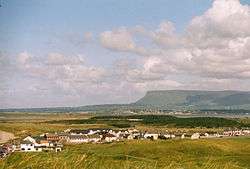 An eastern view.
An eastern view. The back of Benbulbin, as seen between Truskmore and the back of benwiskin on the Glenif Horseshoe, near cliffoney village
The back of Benbulbin, as seen between Truskmore and the back of benwiskin on the Glenif Horseshoe, near cliffoney village A snowy Benbulbin, seen from Streedagh Strand.
A snowy Benbulbin, seen from Streedagh Strand.- Taken on the N15, North of Sligo town, near the village of Rathcormack.
Plane crashes
During World War II there were two plane crashes in the Dartry mountains close to Benbulbin.
On 9 December 1943, a USAAF Boeing B-17G Flying Fortress plane (en route from Goose Bay, Labrador to Prestwick, Scotland) crashed on Truskmore just east of Benbulbin. 10 airmen were aboard, of whom three died, two at the scene and one from injuries sustained in the crash.[19] Local residents undertook a rescue mission, taking the injured off the mountain where they were then transferred to Sligo County Hospital. Substantial wreckage of the plane stayed on the mountain for many years following the crash and today limited amounts of aircraft fragments still remain at the site.[20]
Near the location of the Flying Fortress crash, there was an earlier crash also involving a military aircraft. On 21 March 1941, an RAF Catalina flying boat (AM265) using the Donegal Corridor crashed into the mountain at Glenade, Co. Leitrim on the east side of Truskmore. All nine airmen aboard died in the crash.[20][21]
Recent history
In the 1970s and 1980s, Sinn Féin had engaged in a slogan campaign around the theme 'Brits out of Ireland'. Roads and walls throughout Ireland had been marked with these slogans as was Benbulbin in 1977. It was marked first with 'Brits Out' (180 ft wide and 25 ft high) and then later with the slogan 'H-Block'.
Benbulbin overlooks the village of Mullaghmore, the site of the assassination of Lord Mountbatten in 1979.[22][23]
As stated above, Benbulbin is a protected site, designated as a County Geological Site by Sligo County Council. However, in May 2018, 'Vote No' (8th amendment) campaigners erected a large "NO" sign, severely impacting the iconic view. Sligo County Council responded on social media with the following statement, "As the land where the lettering was placed is commonage, Sligo County Council has no role in this matter".
Notable people
The athlete Mary Cullen is from nearby Drumcliffe.[24] Andy "The Bull" McSharry, involved in a famous 17-year-long dispute over allowing access rights over his land, lives near Benbulbin.[25]
In literature
Benbulbin features prominently in the poetry of W. B. Yeats, after whom Yeats Country is named.[15] County Sligo is considered integral to the poet's work.[26] The mountain is one of the destinations on the Passport Trail of the poet's life.[26]
Yeats wrote the following in The Celtic Twilight:
But for Ben Bulben and Knocknarea,
Many a poor sailor'd be cast away.[27]
The mountain is also mentioned in Yeats's On a Political Prisoner, in which he recalls the Countess Markiewicz riding past it to political meetings.[15]
Yeats's famous poem, Under Ben Bulben, is essentially a description of Yeats Country. It describes the sights that he saw in Yeats Country. The following is an excerpt from Under Ben Bulben:
Under bare Ben Bulben's head
In Drumcliff churchyard Yeats is laid.
An ancestor was rector there
Long years ago, a church stands near,
By the road an ancient cross.
No marble, no conventional phrase;
On limestone quarried near the spot
By his command these words are cut:Cast a cold eye
On life, on death.Horseman, pass by!
— Under Ben Bulben, W.B. Yeats
This was Yeats's final poem, published in The Irish Times.[28] He is buried in Drumcliffe Churchyard, in the shadow of Benbulbin.[15][28][29]
See also
| Wikimedia Commons has media related to Benbulbin. |
- List of mountains in Ireland
- Wiktionary definition of a ben
References
- Benbulbin Placenames Database of Ireland. Retrieved: 2003-03-19.
- Benbulbin Archived 2012-08-29 at the Wayback Machine Ordnance Survey Ireland. Retrieved: 2003-03-19.
- "Mountain Views: Benbulbin in area Dartry Mountains". Retrieved 2007-04-04.
- Reader's Digest Natural Wonders of the World. The Reader's Digest Association, Inc. 1988. ISBN 0-89577-087-3.
- "Yeats Country Drive Sligo". Retrieved 28 July 2012.
- Williams, Mary Anne (2008). Landscapes, Rocks and Fossils: The Geological Heritage of County Sligo: An Action of the County Sligo Heritage Plan. Sligo Regional Technical College. pp. 21, 22. ISBN 0955565316.
- Marese McDonagh (14 March 2009). "Yeats-link 19th century house could face demolition". The Irish Times. Retrieved 7 February 2010.
Sligo Borough Council has confirmed there is a recommendation in the recently published draft Sligo Environs Development Plan that Markievicz House be removed from the list of protected structures. If the elected members vote to delist the building, which in the late 1800s was home to Yeats's maternal grandparents William and Elizabeth Pollexfen, it clears the way for its demolition. [...] Stella Mew, chief executive of the Yeats Society, which is preparing for the 50th International Yeats Summer School this summer, said Sligo's Yeatsian heritage was being "whittled away piece by piece". "Luckily Ben Bulben and Knocknarea are sacrosanct – they cannot delist the mountains or they might be at risk too," she said.
- McGarry, James (1976). Place names in the writings of William Butler Yeats. Smythe. p. 21. ISBN 0901072397.
- "RootsWeb: IRL-SLIGO-L Climbing Benbulben". Archived from the original on 2011-10-03. Retrieved 2007-04-10.
- Marese McDonagh (7 January 2010). "10-fold increase in AE patients in Sligo". The Irish Times. Retrieved 7 February 2010.
These are not people climbing Ben Bulben," he stressed. "This is happening outside people's front doors when they are walking on footpaths or crossing the road.
- Lorna Siggins (24 March 2009). "Arrival of the fittest". The Irish Times. Retrieved 7 February 2010.
She is said to be looking forward to climbing Ben Bulben again, having already done so several times as a student.
- "Léargas". RTÉ. Retrieved 7 February 2010.
As he ascends Ben Bulben, he acutely feels the lack of certainty about his right of access to the uplands.
- "Benbulben (Gortarowey) Looped Walk". Sligo Walks. Retrieved 15 March 2018.
- Edel O'Connell (18 August 2012). "Researchers find first hardy Irish plant that beat Ice Age". Irish Independent. Retrieved 5 September 2012.
- Conner, L.I. (1998). A Yeats Dictionary: Persons and Places in the Poetry of William Butler Yeats. Irish studies. Syracuse University Press. p. 14. ISBN 978-0-8156-2770-8.
- Bright, Michael (2005). 1001 Natural Wonders You Must See Before You Die. Quintet Publishing Limited. ISBN 0-7641-5817-1.
- Sligo: Benbulbin "The Noble Six Cross"© Copyright Michael Murtagh and licensed for reuse under this Creative Commons Licence. Retrieved 3 June 2012.
- "Another link in the Ben Bulben story". The Mayo News. 4 May 2006. Retrieved 7 February 2010.
- http://www.csn.ul.ie/~dan/war/42-31420.pdf
- Dennis P. Burke. "B-17 Flying Fortress 42-31420" (PDF). Retrieved 28 July 2012.
- Joe McGowan (2003). "The Donegal corridor and the Battle of the Atlantic". History Ireland. Retrieved 5 September 2012.
- Kim Bielenberg (11 July 2009). "The day death came from a clear blue sky". Irish Independent. Retrieved 7 February 2010.
- Valerie Shanley (23 August 2009). "The shadow of Mullaghmore". Sunday Tribune. Archived from the original on 9 September 2010. Retrieved 7 February 2010.
- "Athletics: Cullen back on track after year from hell". Irish Independent. 5 December 2009. Retrieved 7 February 2010.
She's from picturesque Drumcliffe, in the heart of Yeats country, surrounded by idyllic sea, sands and Benbulbin but, ironically, the weather has been unseasonably foul and her preparations epitomise the loneliness of the long-distance runner.
- Anita Guidera (22 September 2009). "Hills alive as 17-year walker row resolved". Irish Independent. Retrieved 7 February 2010.
- Anita Guidera (29 January 2009). "Poetry fans tread softly on trail of Yeats's most beloved haunts". Irish Independent. Retrieved 7 February 2010.
- Christopher Somerville (7 November 2009). "Walk of the week: The Rosses Co Sligo". Irish Independent. Retrieved 7 February 2010.
- Joe Joyce (18 September 1948). "WB Yeats laid to rest in Drumcliffe". The Irish Times. Retrieved 7 February 2010.
The scene at Drumcliffe was set by Yeats himself. In his last poem, published in The Irish Times, he wrote: Under bare Ben Bulben's head / In Drumcliffe Churchyard Yeats is laid . . .
- Orla Tinsley (18 July 1948). "Irish coasting". The Irish Times. Retrieved 7 February 2010.
After a quick leg-stretch in Mullaghmore we travel past the looming presence of Ben Bulben on our way to Yeats's grave at Drumcliff.
External links
- Tourist information
- An image of Benbulbin with a small caption
- Information, pictures and a panorama of Benbulbin
- Hiking the Benbulben and the old coal mine
- Sinn Féin Anti British Slogans 1977
Yeats
- An essay on the Benbulbin in Yeats' poetry
- A second site detailing Benbulbin in Yeats' poetry
- Reading of "Under Ben Bulben" by Jim Norton on RTÉ Radio 1
